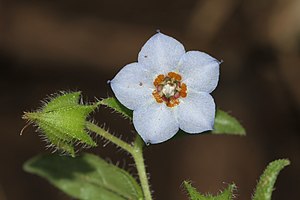Note: This is a project under development. The articles on this wiki are just being initiated and broadly incomplete. You can Help creating new pages.
Difference between revisions of "Trichodesma indicum - Adhapuspi, Indian Borage"
| Line 5: | Line 5: | ||
==Parts Used== | ==Parts Used== | ||
| − | {{Parts Used|Whole plant}}, {{Parts Used|Roots}} | + | {{Parts Used|Whole plant}}, {{Parts Used|Roots}}<ref name="Karnataka Medicinal Plants"/>. |
==Chemical Composition== | ==Chemical Composition== | ||
Latest revision as of 10:55, 3 April 2022
Adhakpuspi is an Indian medicinal plant found in the Indian subcontinent. These are widely distributed as a weed throughout India. They grow to an altitude of about 1500 m in the Himalayas and it is used as a fertiliser and as an herbal medicine.
Contents
Uses
Arthritis, Anorexia, Dysentery, Skin dise, Snake bite, Dairrhea, Dysmenorrhea, Abortion case[1].
Parts Used
Chemical Composition
The seed of the plant contains lenoleic acid, Oleic acid, palmatic acid.The leaves cotains hexaconase, Ethylhexacosanoate, Ethylester and 21, 24 Hexacosadeinoic acid.[2]
Common names
| Language | Common name |
|---|---|
| Kannada | Athomukhi, Kattetumbesoppu |
| Hindi | Anadhahuli, Chotakulpha |
| Malayalam | Kilukkamtumpa |
| Tamil | Kulittaitumpai, Kallutaitumpai |
| Telugu | Guvagatti |
| Marathi | NA |
| Gujarathi | NA |
| Punjabi | NA |
| Kashmiri | NA |
| Sanskrit | Adhapushpi |
| English | Indian Borage |
Habit
Herb.
Identification
Leaf
| Kind | Shape | Feature |
|---|---|---|
| Simple | Oblong-lanceolate | Leaf Apex is Acite and its base is Acute-auriculate.it has entire leaf margin |
.[3]
Flower
| Type | Size | Color and composition | Stamen | More information |
|---|---|---|---|---|
| Unisexual | 4-8cm long | Blue | Flowering from September-November and January-March |
.
Fruit
| Type | Size | Mass | Appearance | Seeds | More information |
|---|---|---|---|---|---|
| Smooth | Smooth on the outer and rugosely pitted on the inner face. | In almost free, 4 nutlets | Fruiting throughout the year. |
Other features
List of Ayurvedic medicine in which the herb is used
Where to get the saplings
Mode of Propagation
How to plant/cultivate
The plant is found as a weed in many areas of the tropics and subtropics.[4]
Commonly seen growing in areas
Himalayas, Cultivated fields, Dry stony wastelands, Black cotton soil.
Photo Gallery
References
- ↑ 1.0 1.1 1.2 ”Karnataka Medicinal Plants Volume - 2” by Dr.M. R. Gurudeva, Page No.49, Published by Divyachandra Prakashana, #45, Paapannana Tota, 1st Main road, Basaveshwara Nagara, Bengaluru.
- ↑ Easy ayurveda
- ↑ Morphology
- ↑ Trophical plants
External Links
- Ayurvedic Herbs known to be helpful to treat Arthritis
- Ayurvedic Herbs known to be helpful to treat Anorexia
- Ayurvedic Herbs known to be helpful to treat Dysentery
- Ayurvedic Herbs known to be helpful to treat Skin dise
- Ayurvedic Herbs known to be helpful to treat Snake bite
- Ayurvedic Herbs known to be helpful to treat Dairrhea
- Ayurvedic Herbs known to be helpful to treat Dysmenorrhea
- Ayurvedic Herbs known to be helpful to treat Abortion case
- Herbs with Whole plant used in medicine
- Herbs with Roots used in medicine
- Herbs with common name in Kannada
- Herbs with common name in Hindi
- Herbs with common name in Malayalam
- Herbs with common name in Tamil
- Herbs with common name in Telugu
- Herbs with common name in Sanskrit
- Herbs with common name in English
- Habit - Herb
- Index of Plants which can be propagated by Seeds
- Herbs that are commonly seen in the region of Himalayas
- Herbs that are commonly seen in the region of Cultivated fields
- Herbs that are commonly seen in the region of Dry stony wastelands
- Herbs that are commonly seen in the region of Black cotton soil
- Herbs
- Ayurvedic herbs that don't have flower, fruit and leaf photos
- Boraginaceae




